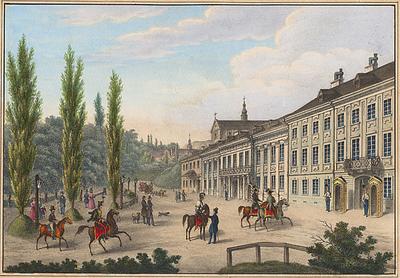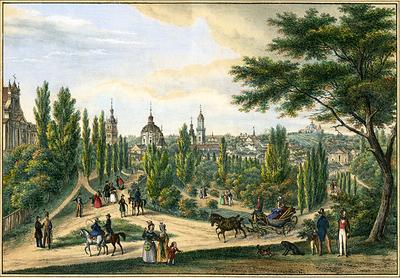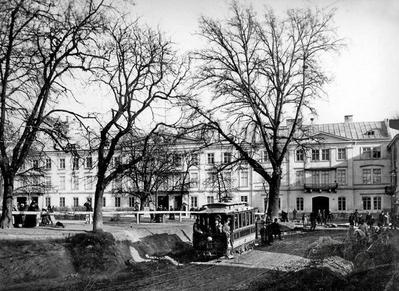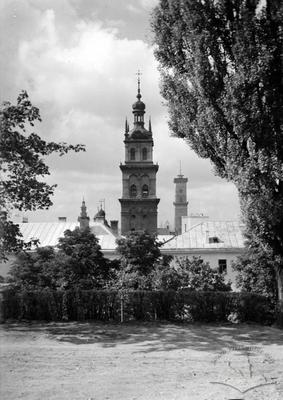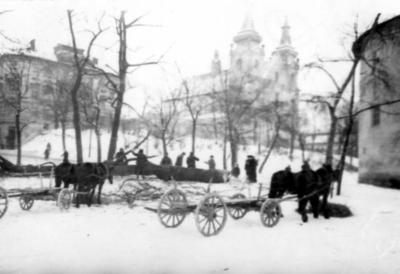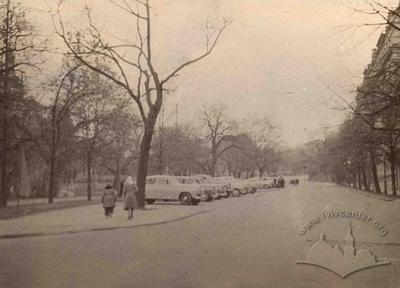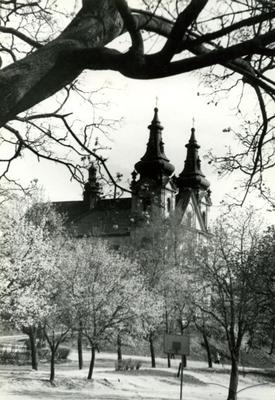Vul. Pidvalna – Vynnychenka Street Greenway (formerly Governor’s Ramparts)
Architecture
On modern maps of Lviv, the greenway built on the former Governor’s Ramparts appears as a leafy stretch running between the parallel streets Pidvalna and Vynnychenka. The territory runs north-south with a gentle rise toward Zamkova Hora (Castle Hill).
The Governor’s Ramparts greenway was established on filled in ground where fortifications often referred to as the “Royal Belvoir” (Fr., belvoir, “beautiful view”) had once stood. The topography of the territory continues to bear the marks of its ‘fortified’ past; the Gunpowder Tower and the City Arsenal nearby, both stand on the territory. The old German gymnasium school (currently, Public School #8) is also in the park.
The impressive silhouettes of notable churches – the Voloska Church, the Dominican Church, and the Discalced Carmelite Church – dominate park sightlines. The Governor’s Ramparts acquired its more modern look toward the end of the 19th century with the laying of the tramline on Valovyi Street and the construction of a new Regency Office building. It was thanks to the efforts of regency counsel Reitsenheim who initiated the plan to establish a green lane “on the eastern ramparts” that, already in the early 20th century, it could be reported that “Italian poplar, chestnut, and other greenery cover the crown of the hill, and flourish the length of this nearly century-old lane…” (Jaworski, 1911, 256). Yet another report states that the 3.05 hectare Governor’s Ramparts park had “a straight lane, planted in linden, chestnut, and maple” (Kowalczuk, 1896, 319).
In the 1940s, Olena Stepaniv states that “on the gradually sloping land there are old-growth linden, chestnut, ash, maple, and acacia” (Stepaniv, 1992, 48).
Together with the lane through the Hetman Ramparts (Svobody Prospect), the Governor’s Ramparts greenway running between Pidvalna and Vynnychenka Streets form the first, inner ring of Lviv parkland zone. The second ring is formed by Ivan Franko Park and Vysokyi Zamok, Znesinnya, Lychakiv, Pohulyanka, Zalizna Voda, and Stryiskyi Parks.
Personalities
Karl Auer. Artist, lithographer.
Karl Bauer. Landscape architect, park
designer.
Franz von Hauer. Governor.
Wilhelm Reitzenheim. Government counselor.
Olena Stepaniv. Historian, geographer, civic
activist.
Franz I. Austrian Emperor.
Franciszek Jaworski. Historian.
Sources
- Ivanochko, U. et al. “Architecture of the late 18th and first half of the 19th Centuries.” Architecture of Lviv: Times and Styles, 13th-21st centuries. Biriulyov, Yuryi, ed. Lviv: Center of Europe Publishing, 2008. 170-237. Print.
- Krypyakevych, Ivan. Historical Walks Around Lviv. Lviv: Kamenyar, 1991. Print.
- Stepaniv, Olena. Contemporary Lviv: A Guidebook. Lviv: Phoenix, 1992. Print.
- Barański, F. Przewodnik po Lwowie: Z planem i widokami Lwowa. Lwów: 1902. Print.
- Jaworski, F. Lwόw stary i wczorajszy (szkice i opowiadania): Z ilustracyami. Wydanie drugie poprawione. Lwów: 1911. Print.
- Kowalczuk, M. “Rozwόj terytoryalny miasta.” Miasto Lwów w okresie samorządu 1870–1895. Lwów: 1896. 299–351. Print.
- Orłowicz, M. Ilustrowany przewodnik po Lwowie: Ze 102 ilustracjami i planem miasta. Wydanie drugie rozszerzone. Lwów – Warszawa: Książnica-Atlas, 1925. Print.
- Stankiewicz, Z. ”Ogrody i plantacje miejskie.” Lwów dawny i dzisiejszy: Praca zbiorowa pod redakcją B. Janusza. Lwów: 1928. 62–71. Print.
Material Assembled by Ihor Zhuk, December 2012.
Media Archive Materials
Related Pictures















